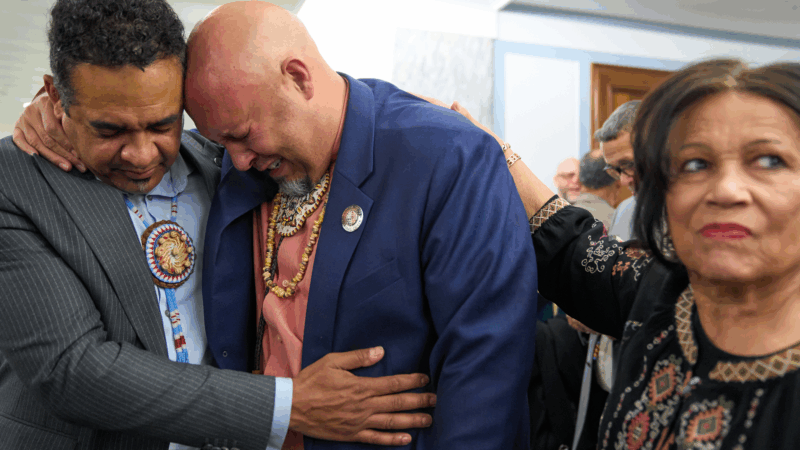Zoos Aren’t Just About Animals Anymore
The Birmingham Zoo is preparing to spend $15 million of an overall $50 million renovation project. Those dollars will be spent on both animal exhibits and non-animal projects. In today’s contemporary world, zoos must wrestle with how best to spend their funds in order to fulfill their missions and draw more diverse folks, who enjoy and expect interactivity. Les Lovoy reports on how the Birmingham Zoo is keeping up with current trends by striking a balance between animal conservation and education and offering an overall entertaining experience for visitors.
From the sound of the crowds, the merry go round and the train, you’d think you were visiting a local theme park. You might be surprised to know you’re at the Birmingham Zoo. All of these activities draw visitors, but it’s still not the main attraction. “We love looking at all the animals.” Leah McDonald is visiting with her young daughter.
“We love being able to walk around in the nice weather,” says McDonald. “We can’t come without going to the carousel and the train. “
Bill Foster is director and CEO of the Birmingham Zoo. He says the zoo primarily focuses on its primary mission; to inspire passion for the natural world. The elephant in the room is the challenge of making a zoo profitable enough to fulfill their mission effectively. This often means costly renovations. Foster says plans are currently in the works for a new animal exhibit, which will take approximately three years to complete.
“This is called the Asian passage,” Foster explains. “ So, you’ll literally be transported from Birmingham, Alabama through a green area, then start studying the people, and the animals of Asia. And, there will be everything from the organgatans to the kamoto dragons, to some wonderful Asian gardens.”
Foster says the zoo is also spending money on things other than animals — upgrading the front entrance, retail stores and eating stations. “I always tell my wonderful staff, if we have to stay in business to keep the doors open, in order to tell our mission, and if we tell that mission and don’t have anybody here, it falls on deaf ears,” Foster says. “So, it’s a business, a not-for-profit business, but a business never the less.”
Foster isn’t the only zoo director who’s had to grin and bare it, while focusing on the bottom line. Satch Krantz is the president and CEO of Riverbanks Zoo and Garden in Columbia, South Carolina. His zoo is often looked at as an example of best practices. He says at one time he was a zoo purist and felt that….”that zoos exist for the animals and for people to come and enjoy them, study them, to learn and to appreciate. And for me, the thought of building and installing a carousel or a zip line as just horrible. ”Krantz says he and his staff had to keep up with the times. “Reality really hit us in the face,” he explains.
And, although the animal advocates on his staff felt they were monkeying around with the zoo’s primary mission, they soon found all of the extra activities had advantages. “When the revenue starting pouring in, and they were able to see direct results of those increases in revenues, our staff has pretty much embraced these things,” he says.
Although the lion’s share of zoo directors have seen the handwriting on the wall, some folks feel zoos are distorting their primary missions to rationalize adding the non-animal activities.
Kris Vehrs is the executive director of the Association of Zoos and Aquariums. She says that’s not necessarily the case. “I think maybe there’s an expansion in the thinking of what can my mission statement encompass,” she explains. “Can it encompass carousel rides where there are endangered species that are animals on the carousel, or zip lines that take me over the animals so I can see them from a different perspective?”
Zoos now know people want an interactive experience. In addition to adding rides and activities, visitors enjoy interacting with the animals. A parrot on their arm or head. Feeding a giraffe. Experiences, which are much more interesting than staring at a sleeping lion. This strategy obviously works. Anthony Porter is visiting the Birmingham Zoo with a handful of his early teenage kids. His take on the modern zoo experience? “Made it a lot better,” he laughs. “You see everything. It makes it more interactive. The kids love it. They want to do stuff. They can’t just look. They got to act.”
And Bill Foster, director of the Birmingham zoo, says it will never be a leopard that changes its spots. Even though there will always be activities like the train, merry go round and splash pad, the zoo’s priorities will always be the welfare of its animals
Apple, Google tell workers on visas to avoid leaving the U.S. amid Trump immigration crackdown
With months-long consulate and embassy delays being reported, the two tech companies say staying put in the U.S. right now could prevent workers from getting stranded in their home countries.
North Carolina’s Lumbee Tribe receives full federal recognition after 137-year effort
The Lumbee Tribe of North Carolina has finally received full federal recognition, which it has sought since 1888. Tribal leaders were moved to tears after President Trump signed the measure.
Pope Leo summons cardinals for a key assembly to help him govern Catholic Church
Pope Leo XIV has summoned the world's cardinals for two days of meetings to help him govern the church, in the clearest sign yet that the new year will signal the unofficial start of his pontificate.
Bowen Yang leaves ‘SNL’ midway through his 8th season
The comedian is scheduled to co-host his final show on Saturday with Wicked star Ariana Grande.
Available to download Friday, some Epstein files no longer there Saturday afternoon
An NPR analysis of the Epstein files shows some documents, originally available on Friday, are no longer on the Department of Justice's "Epstein Library" website as the DOJ releases more files.
U.S. forces stop a 2nd merchant vessel off Venezuela coast, officials say
U.S. forces stopped a vessel off the coast of Venezuela for the second time in less than two weeks as President Trump continues to ramp up pressure on Venezuelan President Nicolás Maduro.







